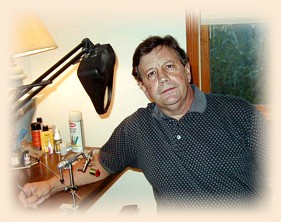When I think of the Rangeley region in Maine, I naturally think of streamers and Carrie
Stevens. Surprisingly enough, there was considerable fishing there long before Carrie
and her husband Wallace appeared on the scene in 1919. The legendary brook trout were
abundant on the chain before Mrs. Stevens had ever tied a single streamer, and the wet
fly was king. Herbert L. Welch was tying feather wing streamers there starting
in 1903 though, and ultimately this style of fly would dominate. You may be familiar
with one of Mr. Welch's early streamers, the Black Ghost.
It is my intent to bring a series of the large and beautiful wet flies from this
region to our pages here in the next few weeks. Many of these flies were trolled
behind row boats and were fished as minnow imitations. The flies were
very often named after the lakes, many of which still had their Abenaki Indian names
in the late 1800s. Starting at the top of the chain of lakes was Oquossoc ("landing
place"), which was to become Rangely Lake, then Mollychunkemunk ("crooked water") which became the upper
Richardson, then Welokennebacook ("red water"), which was renamed lower Richardson.
I'm pleased to report that Mooselookmeguntic and Cupsuptic lakes still retain their
original names. In the case of the Oquossoc, there was a fly named for it as well as one named for
the lake it later became, Rangeley. Most of the lakes had flies named for them,
including Mooselookmeguntic, Cupsuptic, Mollychunkemunk and Oquossoc. This holds true
for many flies originated in the state of Maine, including the Parmachene Belle, Kineo,
New Lake, Kennebago, and B. Pond.
I think many of us view dams as destructive to fishing and the environment generally. It
seems as if the dams that were built in the 1800s in this area actually benefitted the
fishing, creating habitat that resulted in some absolutely huge brook trout. To get an
idea of the impact this kind of fishing had, consider this paragraph written by Joe Bates'
son Bruce, about a trip the family made to Upper Dam in 1942:
"It was tradition to take the newly arrived guests to the sawmill under the downstream
side of the dam. On the lower level there was a trapdoor in the floor, and when opened
it exposed the huge trout that cruised in the backwater underneath the dam. The combination
of the size of the trout, the darkness of the sawmill, and the roaring of the water raging
through the dam was thrilling but scary for a 10-year-old. Particularly as some of the
fish looked almost as long as I was tall."
Ten pound brook trout were not uncommon, so fishing was, as you can imagine, quite
good. Here is the recipe for the Rangeley to get us started, with more flies from
the region to come in future articles:
Rangeley #1 (pictured above)
Tail: Scarlet and wood duck
Ribbing: Gold tinsel
Body: Claret dubbing
Hackle: Claret palmered over body
Wing: Barred wood duck; scarlet and turkey strips
Rangeley #2
Tail: Yellow fibers
Body: Orange floss
Hackle: Claret palmered over body
Wing: Gray turkey and mallard
Rangely #3 (Bergman)
Tip: Gold tinsel
Tail: Orange
Ribbing: Gold tinsel
Body: Light claret dubbing
Hackle: Orange shoulder, light claret palmered over body
Wing: Gray mallard, jungle cock eye
Credits: Trout by Ray Bergman; Flies by J. Edson Leonard; Carrie Stevens
by Graydon R. Hilyard. ~ EA
About Eric:
 Eric lives in Delaware, Ohio and fishes for brown trout in
the Mad River, a beautiful spring creek. More of his flies
are on display here:
Traditionalflies.com -- Classic salmon and
trout flies of Europe and the Americas.
Eric lives in Delaware, Ohio and fishes for brown trout in
the Mad River, a beautiful spring creek. More of his flies
are on display here:
Traditionalflies.com -- Classic salmon and
trout flies of Europe and the Americas.
|


 Eric lives in Delaware, Ohio and fishes for brown trout in
the Mad River, a beautiful spring creek. More of his flies
are on display here:
Traditionalflies.com -- Classic salmon and
trout flies of Europe and the Americas.
Eric lives in Delaware, Ohio and fishes for brown trout in
the Mad River, a beautiful spring creek. More of his flies
are on display here:
Traditionalflies.com -- Classic salmon and
trout flies of Europe and the Americas.